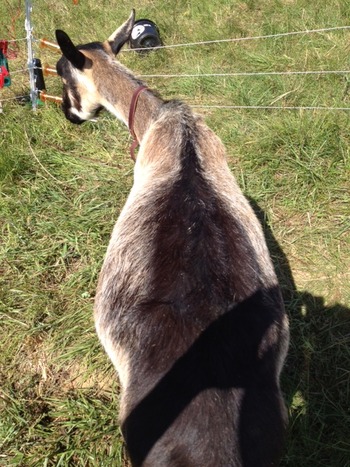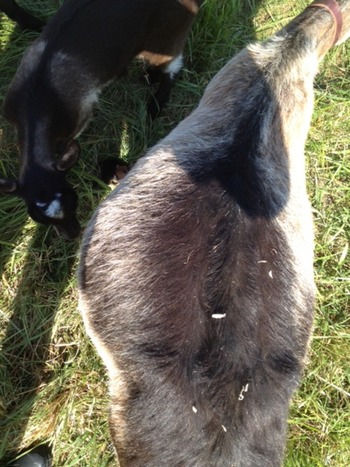Each day we learn many new things. Some out of necessity, some from mistakes. Today we had our first run-in with bloat.
Mayday's Got the Bloat
This morning Sweetbreads noticed that Mayday looked a little misshapen. I thought she looked a little more rotund than usual, but typically that’s just a sign of healthiness for goats. Mayday has two kids nursing on her and is a couple weeks away from weaning the little tykes so I thought maybe she was starting to get her body condition back.
Sweetbreads, on the other hand, spent a little more time with the goats and had a suspicion that this might be bloat. We had read about it before we ever owned a goat - dreaded encountering it, and now, here it was. You can see in the photo that her left side was much larger than her right. We learned that this is one of the symptoms of bloat. The rumen is bigger on the left side and that’s the part of the stomach where the bloating occurs.
What’s Bloat and Why Do We Care?
Bloat for animals isn’t quite like the bloat that I get after eating a lot of mexican food and drinking beer. For me, it’s just time for a nap. For animals it can be fatal. Ruminants, such as goats, cows, sheep, giraffes and many other mammals, actually have four stomach compartments. The term ruminant comes from the latin word meaning “chew again”, which is exactly what they do. The ruminants eat plants, the plants go into the first stomach (the rumen) where some bacteria help it digest a little bit and then the plants go into the second stomach (the reticulum) where they form a “bolus”. The bolus is regurgitated and chewed again. That’s known as chewing the cud. The goats look like a bunch of baseball players with some chaw in, only they don’t spit. Normally they’ll all chew cud around the same time, it’s pretty funny watching the kids do it. Like an 6 year old with a big wad of bubble gum in the T-ball dugout.
Anyway, back to bloat. Typically, bloat is caused by a sudden change in diet, which causes disruption in the animal’s gut. The critical stomach when it comes to bloat is the rumen. In the rumen, bacteria break down and digest the forage. It’s one of the primary reasons that goats can eat and digest grass and humans can’t. They have a rumen, we don’t. When the rumen pH is out of whack (which can result from anything from getting into the grain bin and having a pig-out session to chowing down on particularly lush forage after only eating hay for months) it can create excess gases, or gases trapped in a frothy foam, that the animal can’t immediately get rid of. If left unattended the animal can die.
With a goat the rumen is on the left side. That’s what keyed us in on Mayday’s situation. Her left side was huge. She also kept coming up to Sweetbreads in the pasture and resting her forehead against her, which is not typical of Mayday. If an animal looks or acts different we just assume something’s wrong. Mayday didn’t all of the sudden develop an affinity for Sweetbreads. Something was up. We also knew that yesterday was a rainy day, so the goats likely didn’t graze as much as they typically would. Mayday’s stomach was more empty than usual when she came in to be milked and ate her grain/sunflower seeds. Our guess is that this is what upset the balance of her stomach flora and led to the bloat, although you can never be totally sure.
How Did We Eliminate the Bloat?
We are not vets. We have only owned goats for a month. Take that into consideration. But what we did worked, so hopefully others find it helpful.
 We filled a drencher with about ⅓ cup of olive oil mixed with some stevia (to make it more palatable) and fed it to Mayday. The oil breaks up the smaller bubbles of gas, allowing one larger bubble (that can be passed) to form. Then we massaged her distended side and let her rumen work its magic. This isn’t exactly pleasant because that gas makes its way out in only two ways, but it’s really a fantastic feeling when you can help the poor goat recover from what could be a fatal problem. After a good 15 minutes of rubbing and patting (like burping a baby) Mayday had shrunk back to her normal size and we were out of the woods. Sweetbreads checked on her throughout the day and repeated the rumen massage once more in the early afternoon. By the time we tucked the herd in for the night, she was back to her normal self, minus some of her previous crankyness.
We filled a drencher with about ⅓ cup of olive oil mixed with some stevia (to make it more palatable) and fed it to Mayday. The oil breaks up the smaller bubbles of gas, allowing one larger bubble (that can be passed) to form. Then we massaged her distended side and let her rumen work its magic. This isn’t exactly pleasant because that gas makes its way out in only two ways, but it’s really a fantastic feeling when you can help the poor goat recover from what could be a fatal problem. After a good 15 minutes of rubbing and patting (like burping a baby) Mayday had shrunk back to her normal size and we were out of the woods. Sweetbreads checked on her throughout the day and repeated the rumen massage once more in the early afternoon. By the time we tucked the herd in for the night, she was back to her normal self, minus some of her previous crankyness.


